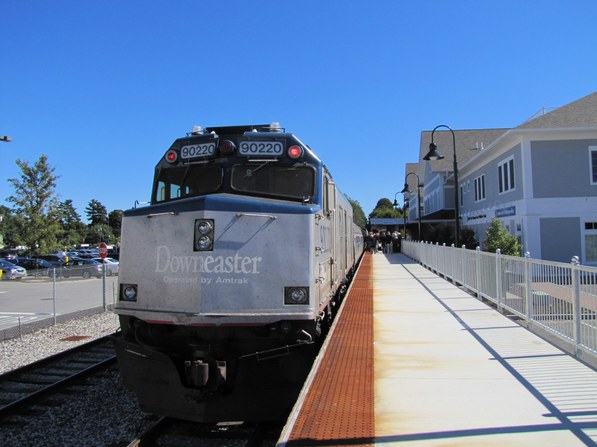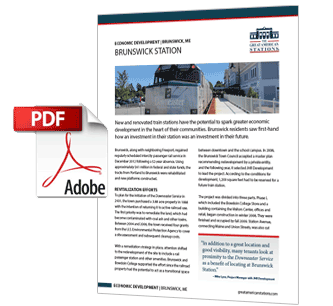New and renovated train stations have the potential to spark greater economic development in the heart of their communities. Brunswick residents saw first-hand how an investment in their station was an investment in their future.

Brunswick, along with neighboring Freeport, regained regularly scheduled intercity passenger rail service in December 2012 following a 52-year absence. Using approximately $41 million in federal and state funds, the tracks from Portland to Brunswick were rehabilitated and new platforms constructed.
Revitalization Efforts
To plan for the initiation of the Downeaster Service in 2001, the town purchased a 3.88 acre property in 1998 with the intention of returning it to active railroad use.The first priority was to remediate the land, which had become contaminated with coal ash and other toxins. Between 2004 and 2006, the town received four grants from the U.S. Environmental Protection Agency to cover a site assessment and subsequent cleanup costs.
With a remediation strategy in place, attention shifted to the redevelopment of the site to include a rail passenger station and other amenities. Brunswick and Bowdoin College supported the effort since the railroad property had the potential to act as a transitional space between downtown and the school campus. In 2006, the Brunswick Town Council accepted a master plan recommending redevelopment by a private entity, and the following year, it selected JHR Development to lead the project. According to the conditions for development, 1,200 square feet had to be reserved for a future train station.
“In addition to a great location and good visibility, many tenants look at proximity to the Downeaster Service as a benefit of locating at Brunswick Station.” – Mike Lyne, Project Manager with JHR Development
The project was divided into three parts. Phase I, which included the Bowdoin College Store and a building containing the Visitors Center, offices and retail, began construction in winter 2008. They were finished and occupied by fall 2009. Station Avenue, connecting Maine and Union Streets, was also cut through the site south of the proposed buildings. Phase II began in fall 2010 when ground broke for the 52-room Inn at Brunswick Station. An office building was also constructed, and both projects were open by late summer 2011. Phase III, consisting of a residential building with office and retail space, is still in development. As of late 2013, the inn and nine additional tenants occupied Brunswick Station.
Public funding for Brunswick Station amounted to approximately $5.2 million obtained through a mix of federal, state and local funds. The town government estimates that these public funds have leveraged more than $25 million in private investment by the developer.
Economic Impacts
Once a contaminated brownfield parcel, Brunswick Station is now an economically vibrant area whose businesses contribute property and sales tax revenue to the city and state. The new, attractive buildings also bolster local land values.
During a 2011 property assessment, the town estimated that since 2008, the value of the Brunswick Station property had increased from $676,700 to $6,725,400—almost a tenfold gain. The existing businesses had also generated 97 new full time jobs in the hospitality, retail, food service and medical industries.
Doug Lavallee, owner of the Brunswick Station restaurant Scarlet Begonias, said in an October 2013 Bangor Daily News article: “We get people getting off the train, people buying food to go…It’s been a really positive effect for the whole area.” Mike Lyne of JHR Development confirms this sentiment, adding, “I would say our two restaurants would cite the rail service as one of the primary reasons for locating at Brunswick Station.”
Keys to Success
- With public input, the city established a long-term master plan to guide development.
- Federal, state and local funding sources used.
- Mixed-use complex ensures activity all day.
- Site serves both downtown and the campus of Bowdoin College.



 Amtrak established the Great American Stations Project in 2006 to educate communities on the benefits of redeveloping train stations, offer tools to community leaders to preserve their stations, and provide the appropriate Amtrak resources.
Amtrak established the Great American Stations Project in 2006 to educate communities on the benefits of redeveloping train stations, offer tools to community leaders to preserve their stations, and provide the appropriate Amtrak resources. Amtrak is seizing a once-in-a-lifetime opportunity to transform rail and Retrain Travel. By modernizing, enhancing and expanding trains, stations and infrastructure, Amtrak is meeting the rising demand for train travel. Amtrak offers unforgettable experiences to more than 500 destinations across 46 states and parts of Canada. Learn more at
Amtrak is seizing a once-in-a-lifetime opportunity to transform rail and Retrain Travel. By modernizing, enhancing and expanding trains, stations and infrastructure, Amtrak is meeting the rising demand for train travel. Amtrak offers unforgettable experiences to more than 500 destinations across 46 states and parts of Canada. Learn more at